Paleo vs Keto Diets: 4 Huge Differences (+ Which Is Best)
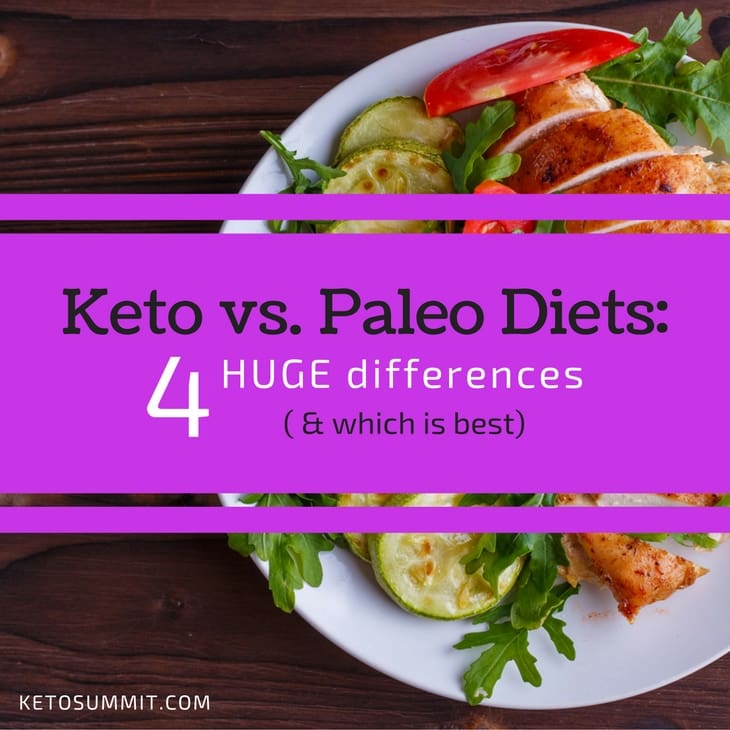
This is it! Today’s the day. You’re finally ready to make a change, to lose the weight and improve your health for good! And then…it happens.
You start researching, pulling up article after article, and by the time you’re done reading them all you’re more confused than ever.
Keto? Paleo?
What’s the difference?
More importantly: which one should you do? Is one of them going to help you lose more weight? Is one of them better for your health?
Well, today I’m going to clear that up for you. There are a lot of low-carb diets out there, and they’re not the same.
In fact, there are 4 major differences between Keto and Paleo — and I cover all of them below.
Plus an easy to remember trick to tell them apart, and advice on which you should follow based on your health goals.
So let’s dive in!
A Quick Summary of The Differences Between Paleo vs Keto Diets:
- Focus on Ketone Levels: A ketogenic diet focuses on raising your body’s ketone levels by altering your food choices so you enter a metabolic state called nutritional ketosis. A Paleo diet doesn’t pay attention to ketone levels.
- Focus on Food Quality: A Paleo diet focuses strongly on choosing whole foods that are nutrient-dense, high-quality, and free from toxins. A healthy ketogenic diet should also include high quality food, but this isn’t the emphasis.
- Amount of Carbs: A Keto diet has a very low carbohydrate intake. While a Paleo diet is certainly lower in carbs than many other diets out there, it typically still has a higher carb intake than a ketogenic diet.
- Amount of Fat: A Keto diet puts far greater emphasis on increasing your fat intake than a Paleo diet. Although Paleo does encourage eating healthy fats, it’s not typically as high fat as a Keto diet.
This is a very brief explanation of the differences between Keto and Paleo, so please keep reading to discover more about both diets.
Want to figure out which diet is best for you?
We’ll cover that below…
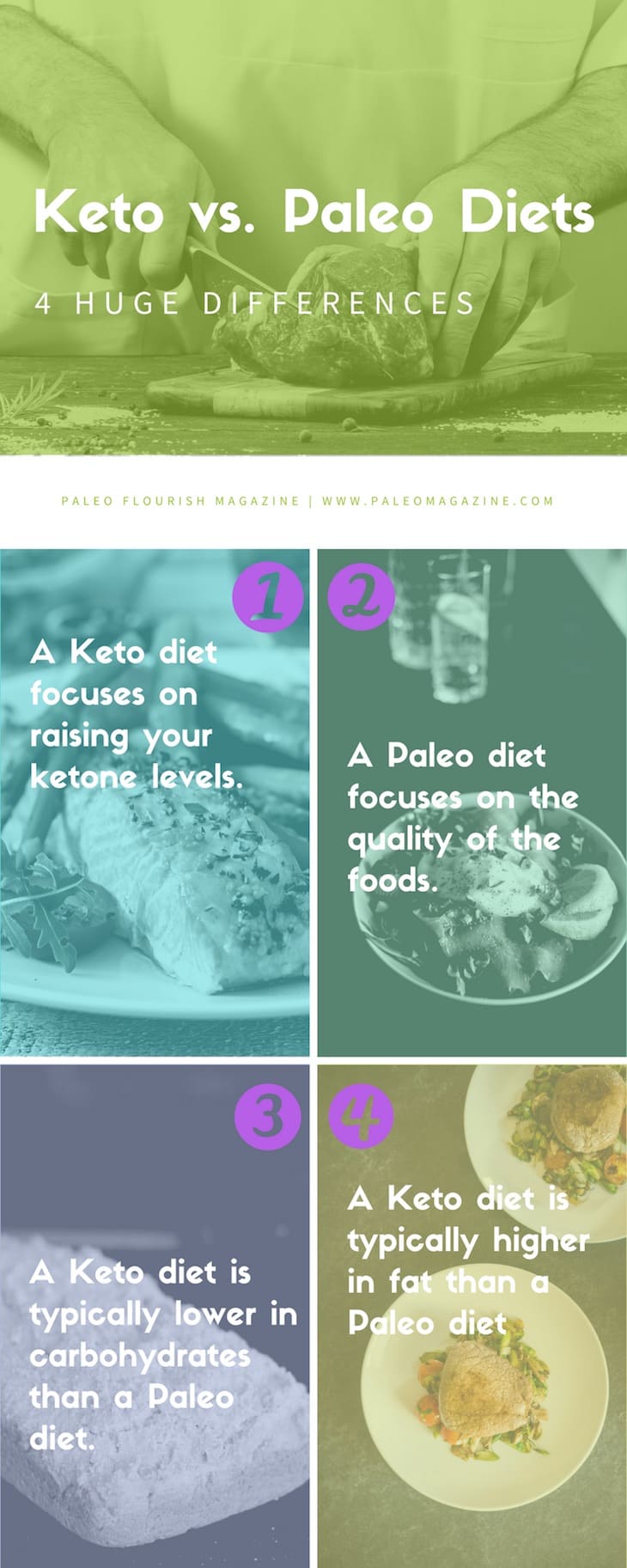
The 4 Main Differences Between A Keto And Paleo Diet:
Here’s a more detailed breakdown of the key differences between Keto and Paleo:
Keto vs Paleo – Difference #1 – A Keto diet focuses on raising your ketone levels.
The Keto diet has one main aim: raising your ketone levels so you reach nutritional ketosis.
If you’re new to all this, then ketosis might be a bit confusing. So let me explain…
What are ketones?
Ketones (or ketone bodies) are naturally produced by your body when you have less glucose to fuel your body. For example, many of us have measurable ketone levels when we wake up in the morning having not eaten since dinner the night before.
Why do we produce ketones?
Evolutionarily, ketones make sense. We didn’t used to have access to so much food – and definitely not to so much carbohydrates (or glucose). So, our bodies use ketones when glucose is scarce.
When food is plenty, we would eat a ton and all that excess food would get stored as fat in our body.
Then, when food or high-carbohydrate foods ran out, we’d break down our fat stores to create ketones which would then fuel our body and brain.
So what exactly is “nutritional ketosis”? Dr. Stephen Phinney, M.D., Chief Medical Officer and Co-Founder of Virta Health actually coined the term. He says, “Nutritional ketosis is a natural metabolic state in which your body is fueled mainly by fats and ketones, instead of carbohydrates (glucose).”
He adds, “Nutritional ketosis happens when carbohydrate consumption goes low enough that a person’s liver can convert adipose tissue and dietary fats into a fatty acid known as ketones, then burn the ketones for energy.”
But we have plenty of food nowadays, so why do we care about ketones and ketosis?
Benefits of Nutritional Ketosis
It just happens that being in nutritional ketosis or having higher than normal ketone levels have been linked to a number of health benefits, including:
- lowering high blood pressure (1)
- losing weight (2)
- stabilizing blood sugar levels (3)
- clearing brain fog and improving focus (4)
- alleviating the symptoms of epilepsy (5)
- improving your cholesterol levels (6)
There’s also growing research and interest in the keto diet and ketosis because of its potential to cure cancer and heal neurodegenerative diseases like Alzheimer’s. (7)
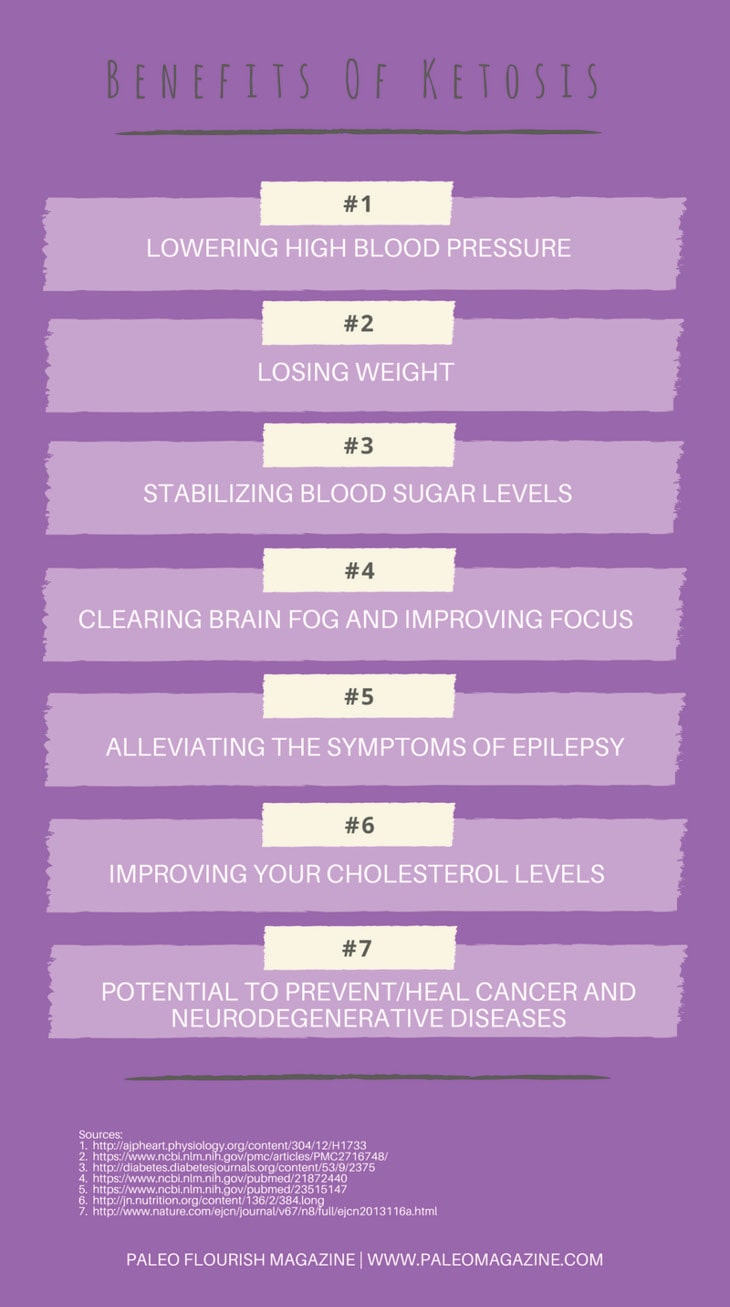
Keto vs Paleo – Difference #2 – A Paleo diet focuses on the quality of the foods.
Paleo principles mean consuming high quality foods that will maximize your nutrient intake while minimizing the chemicals/toxins you’re exposed to.
The diet is based on ancestral eating principles (i.e., eating what people ate for a long time in the past). And that’s why Paleo is often nicknamed “the caveman diet”.
Licensed Registered Dietitian Nutritionist, Diana Rodgers, RD, LDN says, “We’re overfed, obese, exhausted and malnourished all at the same time. Maybe we need to eat less fillers and more real food.” She and other Paleo advocates encourage people to eat a diet that is focused on nutrient dense “real” foods, rather than foods that are processed.
The basics of a Paleo diet
Paleo basically involves:
- Avoiding processed foods with added sugar, cutting out vegetable and other hydrogenated oils and also eliminating grains and legumes (including, wheat, barley, oats, corn, soy, peanuts, and beans).
- Instead consuming plenty of vegetables, meats, fish, seafoods, organ meats, healthy fats, and moderate amounts of fruit, nuts and seeds.
But, why eat like a caveman?
There’s a lot more nuance to the diet than just eating like our caveman ancestors, and you can read more about it here.
Here are a few highlights:
- The trans-fats found in hydrogenated vegetable oils (even supposedly healthy ones like canola and sunflower oils) can increase your risk of illnesses like Alzheimer’s and cardiovascular disease. (7, 8)
- And wheat, rye and barley all contain gluten which can trigger inflammation in your gut even if you’re not celiac or gluten-sensitive.
- Other grains contain similar proteins (called prolamins) which cause similar problems.
- Beans often cause digestive issues (even when properly cooked) and contain anti-nutrients that can decrease the amount of nutrients you can absorb from your meal.
- Soy can cause various hormonal shifts.
- Organ meats like beef liver, shellfish like oysters, and vegetables like kale are super nutrient-dense. That means they contain a lot more vitamins and minerals per calorie you eat than most other foods.
That’s why what you eat really matters. Some foods can nourish your body by filling it with vitamins and minerals while others can cause inflammation.
Keto vs Paleo – Difference #3 – A Keto diet is typically lower in carbohydrates than a Paleo diet.
Although both Paleo and Keto are lower in carbohydrates than the standard American diet (SAD), Keto is typically much lower in carbs than Paleo.
This lower carbohydrate requirement for Keto helps people get into nutritional ketosis more easily.
Paleo foods that are high in carbs
Certain Paleo foods aren’t considered Keto because they contain high net carbohydrate levels. Eating a regular amount of them would raise your blood glucose levels and thereby lower your blood ketone levels.
When it comes to Paleo vs Keto – here are some high-carb Paleo foods that should be avoided on Keto:
- Sweet potatoes and starchy vegetables like pumpkin, squash, yams, carrots, and parsnips
- High-sugar fruits like bananas, peaches, grapes and pineapples
- Paleo-approved sugars like honey, maple syrup, coconut sugar and dried fruits (raisins, dates, dried mango)
Functional Nutritionist and digestive health expert, Michal Ofer says that reducing carbohydrates simply isn’t right for everyone. “It is important to remember that carbohydrates are NOT the enemy and a low carbohydrate diet is not necessarily the best choice for everyone. While low carbohydrate plans are undeniably valuable for individuals suffering from [numerous medical conditions], other individuals can truly benefit from 1-3 servings of nutrient dense starches per day.”
In fact, many Paleo folks end up eating a lot of carbohydrates especially if they have a sweet tooth. (There are a lot of Paleo dessert recipes out there!) But that doesn’t mean you have to eat a lot of carbohydrates on a Paleo diet.
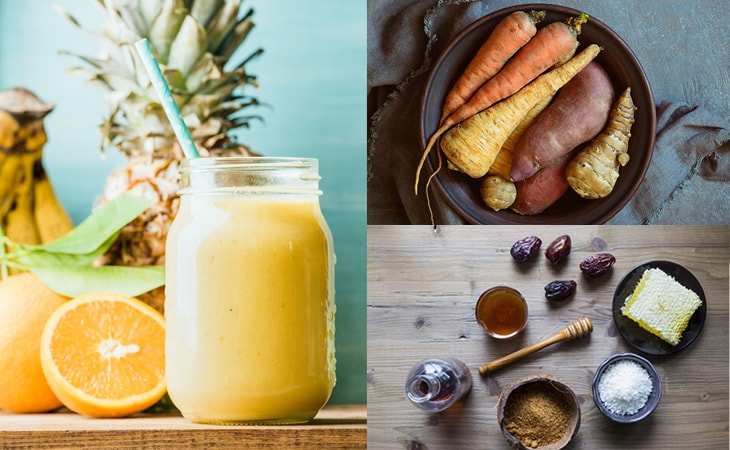
Paleo can be low in carbs too
Even before Keto got popular, many folks have been eating Paleo diets that very closely resemble Keto diets. For many of them, eating a low carb Paleo diet worked well – for weight loss, for digestive issues, and for mental focus.
But that doesn’t make carbs bad to eat.
Carbs are not evil
Carbohydrates serve as a highly useful fuel for our bodies and as food for our good gut bacteria.
However, overeating carbohydrates over a long time could lead to:
- chronic inflammation,
- blood sugar problems,
- tiredness,
- weight gain.
So, if you’re metabolically deranged (i.e., your body doesn’t react to you eating carbohydrates well), then cutting out those carbs can help you regain your metabolic flexibility (i.e., your body can switch between burning fat and burning sugar easily).
Wait a minute, this sounds like the low carb diet and Atkins all over again…
What about Keto vs Atkins?
Although Keto may sound similar to Atkins, the key difference is again in the focus of each diet.
The focus of the Atkin’s diet is to limit carbohydrate intake. There’s very little emphasis on food quality or other aspects of a healthy lifestyle.
That has led some people on Atkins to eat poor quality junk foods (like diet coke and treats sweetened with artificial sugars) while missing out on nutritious foods (like green leafy vegetables, organ meats, or seafood).
However, there’s one version of Keto (also known as the Modified Atkin’s diet) that is getting more popular.
The Modified Atkin’s diet can be great for weight loss.
The reason why the Modified Atkin’s diet is gaining in popularity is because it works well for weight loss (and compliance on the diet).
This is often a higher-protein version and slightly higher carb version of the standard ketogenic diet.
Keto vs Paleo – Difference #4 – A Keto diet is typically higher in fat than a Paleo diet.
Both Paleo and Keto involve consuming healthy fats as part of a balanced diet, but Keto is usually considered higher in fat than Paleo.
Paleo dieters tend to not eat that much fat
A Paleo diet recommends eating healthy fats like avocado oil, coconut oil, ghee, lard, tallow and duck fat. And lots of Paleo experts make a point of encouraging people not to be afraid of eating fats.
Functional Health Registered Nurse and Certified Nutritional Therapist Katy Haldiman, RN., notes that Paleo doesn’t necessarily follow a strict set of macros at all. “Part of what makes Paleo a “template” versus a “diet” is that it can be customized to suit a particular individual’s needs. There are many different macronutrient combinations of carbohydrates, proteins, and fats that are possible when following a Paleo template. It often takes some experimentation to discover what version of Paleo will work best for you in order to achieve your goals.”
Even though that’s the case, most Paleo folks opt for low fat chicken recipes and tend to reduce fat where possible, especially if their goals include weight loss.
Keto dieters tend to eat more fat
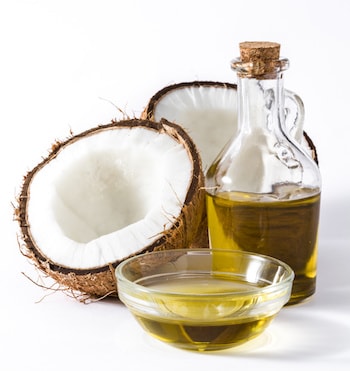 Keto dieters (and other followers of the Low Carb High Fat movement) do exactly the opposite: they often considerably increase their fat intake.
Keto dieters (and other followers of the Low Carb High Fat movement) do exactly the opposite: they often considerably increase their fat intake.
While you should increase your fat intake on a keto diet, you don’t need to slather coconut oil or ghee on everything you cook. And you don’t need to add pork rinds and bacon to every single dish!
But we do encourage you to choose fattier cuts of meat, leave the skin on your chicken and to use sufficient fats in your cooking.
You’ll want to make sure you stick to Paleo approved oils though to avoid rancid and highly-inflammatory oils.
5 Things Paleo Gets Right (that Keto Dieters Should Also Do)
Paleo diets often emphasize the following 5 things, and a health Keto diet should also take them into account.
Stay Dairy-free
On the Paleo diet, dairy can be a bit of a gray area. Most folks avoid dairy but there are some who do include it in their diet like Mark Sisson and others in the Primal movement.
Keto dieters often eat dairy products because they’re high in fats while also being low in carbohydrates, so cheese is a favorite snack food.
Skipping dairy, even though it’s nutritious, can be highly beneficial for your health. Eating dairy products has been linked to acne, sinus problems, digestive issues and conditions involving inflammation (like joint pain). It’s also a problem for people with blood sugar issues and it’s easy to overeat.
Many people are mildly intolerant to at least one of three components in dairy: lactose, casein or whey. These allergies can be so mild they pass unnoticed – until you try eliminating dairy for 30-60 days and find your lingering health conditions disappear!
So it’s best to experiment with cutting out dairy temporarily. In fact, we’d recommend sticking to a dairy-free version of both Keto and Paleo to avoid overeating (which helps with weight loss) and reduce inflammation-related health problems.
As Dr. Mark Hyman, M.D., says, “Get your calcium from food. These include dark green leafy vegetables, sesame tahini, sea vegetables, and sardines or salmon with the bones.”
Avoid Processed Low-carb Foods (e.g. Artificial Sweeteners)
The Paleo diet cuts out most processed food, especially ones with artificial sweeteners and additives.
However, on the Keto diet the only requirements are that your food is low-carb/high fat. This means diet soda is technically Keto approved and so are other artificially sweetened low-carb junk foods.
But we still suggest you avoid artificial sweeteners…
They can trigger sugar cravings by activating the same pathways in your brain as sugar. And they can lead to overeating due to their lack of nutrients: our bodies expect vitamins, minerals and nourishment from the food we eat, so when they don’t get those we crave more food to make up for the shortfall. Most disturbingly of all, one study linked consuming certain artificial sweeteners with metabolic syndrome, heart disease and learning difficulties.
Our advice is to avoid them whichever diet you choose – they’re just not worth the harm they do to your body. But if you find yourself looking for a sweetener to use, the healthiest option is pure stevia.
Add in Exercise
Paleo is normally associated with CrossFit, weight-lifting to a minor degree, and other exercises which focus on natural movements. That’s because it’s not just about imitating how our ancestors ate but also how they moved.
Keto, on the other hand, doesn’t usually mention exercise at all, unless it’s advice for bodybuilders looking to get lean ahead of a big competition.
However, exercise is important no matter what food you eat. It’s a key part of having a healthy lifestyle.

And increasing the amount of exercise you do can be surprisingly easy. Something as simple as walking more can reduce your risk of heart disease, stroke, asthma and some cancers according to the UK’s health regulation service. And playing a sport or practicing yoga can also be fun ways to stay healthy – there are so many different types of exercise out there you’re sure to find one you enjoy.
So make sure to include some exercise in your routine. And if you’re an athlete, exercise very heavily, or your career involves being very active each day, then you may need to increase your carbohydrate intake accordingly on both the Paleo and Keto diets.
Destress
Paleo also emphasizes lowering your stress levels as our ancestors didn’t live with so much chronic stress. Their stress depended on actual physical threats instead of being the lingering constant stress so many folks experience in modern times.
Keto doesn’t explicitly mention relieving stress as part of the diet, as its focus is strictly on nutrition rather than surrounding lifestyle factors.
However, lowering your stress levels is always a good idea.
As well as feeling unpleasant, chronic stress can lead to health problems.
One study linked chronic stress to metabolic syndrome and cardiovascular disease. (9) A great way to beat stress is meditation: something as small as 10 minutes of meditation a day can help you decrease your anxiety and lower your stress levels. As an added bonus, practicing meditation before bed will relax you, meaning you get a better night’s sleep.
Decreasing stress will help you feel calmer and more in control of your life and you’ll be better able to focus on eating the healthiest diet for your body, whether that’s Paleo or Keto.
Sleep More and Better
Paleo recommends making sure you’re getting enough good quality rest each night.
Keto doesn’t make any recommendations regarding sleep, although some keto dieters do report experiencing interesting changes to their sleep cycles. (10)
Good sleep is vital for your health: a study summarized the effects of sleep deprivation, which include high blood pressure, craving for comfort foods, inflammation, and a depressed mood. (11)
There are certain sleep habits you can develop to make sure your body gets the rest it needs.
Try making sure you get bright light every morning, using blackout curtains, avoiding blue light in the evening, sleeping in cooler temperatures (turn down your thermostat or open a window) and developing a relaxing evening routine. (12, 13)
No matter which diet you choose, eating better can often help you sleep better too. The reverse is also true: better sleep means you’ll make healthier food choices and find it easier to stick to the diet you choose.
An Easy Way To Think Of Keto
There’s a very simple way of thinking about Keto if you’re feeling a little overwhelmed by all the differences:
Think of Keto as a low-carb version of Paleo.
Eating Keto basically means eating the same Paleo diet you know and love, but avoiding the high-carb foods. That means no starchy vegetables, no high-sugar fruits and no sugars except stevia.
You can also think of Keto as a tool to use occasionally when you need to boost your health and vitality or you want to lose a little weight – while keeping Paleo as your main diet for everyday life.
But we’ll go into more details on that in the next section.
So Which Diet is Best – Paleo or Keto?
We’ve put together a list of the most common scenarios and which diet is the better fit for each of them.
That way you can figure out whether Keto or Paleo is right for you!
Have a look and see which one applies to you:
- If weight loss is your main aim (e.g. you’ve just come back from holiday and need to lose a few extra pounds) – Keto
- If you’re struggling with a sweet tooth and want to stop your cravings – Keto
- If you’re making the switch to a healthier diet in general and need easy guidelines (e.g. your diet currently involves lots of highly-processed foods) – Paleo
- If you need a diet with more flexibility (e.g. you’re cooking for family members/children or your work involves lots of travel) – Paleo
- If you want to increase your energy by balancing your blood sugar levels (e.g. you often feel sleepy in the afternoons and find your energy spikes and crashes throughout the day) – Keto
- If you’ve got a big project coming up and need to increase mental clarity and focus – Keto
- If you’re currently clearing up existing health problems (like an autoimmune condition or digestive issues) – Paleo
There’s no reason you can’t combine the two and be Keto while following Paleo whole-food and lifestyle based principles, giving you the best of both worlds. Or you can be Paleo and periodically switch to Keto for a few months, when you need a boost.
Always remember the best diet is one you can actually stick to. The goal is to make healthy, sustainable changes to your lifestyle instead of relying on a quick fix to drop weight fast.
So think about your long term goals and make choices that support those!
Now that you know which diet is right for you…
Get all the information you need to get started on Keto right here!
Or, if Paleo’s the way you want to go, check out this fantastic guide to getting started on Paleo by our sister site, Paleo Flourish!
